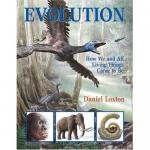Daniel Loxton  has crafted an
adventurous story about evolution.
Not only is the science accurate
but it is also presented in a
way that draws kids of all ages into
Darwin’s “mystery of mysteries.”
This book took me back to childhood
Saturdays in the library
immersed in a journey that I did
not want to end. The adventure
starts with a dinosaur nearly leaping
out of the page, and then
Loxton introduces us to the usual
evolutionary suspects — Darwin
and Cuvier — and unexpectedly to
a young woman, Mary Anning, who
hunted fossils for a living. The
inclusion of Anning is perfect for
young girls wondering what
adventures to pursue in life —
teaching them that they too can
indeed take on science.
has crafted an
adventurous story about evolution.
Not only is the science accurate
but it is also presented in a
way that draws kids of all ages into
Darwin’s “mystery of mysteries.”
This book took me back to childhood
Saturdays in the library
immersed in a journey that I did
not want to end. The adventure
starts with a dinosaur nearly leaping
out of the page, and then
Loxton introduces us to the usual
evolutionary suspects — Darwin
and Cuvier — and unexpectedly to
a young woman, Mary Anning, who
hunted fossils for a living. The
inclusion of Anning is perfect for
young girls wondering what
adventures to pursue in life —
teaching them that they too can
indeed take on science.
Our guide wastes no time in providing a clear description of the mechanism of evolution in three easy-to-understand steps: struggle among and between individuals, variation and natural selection acting on it, and the passing on of characteristics to the next generation, and voila! evolution explained. From that point, Loxton gently guides us along the trail of Darwin’s big idea — to the land of “Zooks” (imaginary zebra-like beasts), where we learn how species can split, and on to stories of adaptations as answers to questions posed by nature. Here a gorgeous pterodactyl flies off the page, and there the first amphibians crawl on to dry land to mingle with the first vascular plants, portending the later invention of trees with trunks as an answer to the question of how to trap the most light to make the most food. Pretty soon we are face to face with our own ancestors. Loxton makes that speciation event seem as natural as flowing water, and then unobtrusively points out that the species resulting from those early ancestors has control of the destinies of all other species — indeed that of the whole planet — through technological evolution.
Loxton does miss several teachable moments that could provide young students with non-magical and logic-strengthening insights on how life on the planet is interconnected. One of the omissions is a page devoted to the actual molecular basis of evolution — a depiction of the elegance of a DNA molecule. Elementary students easily grasp the concept of molecular structure and the energetic glue that holds them together, and this understanding can then be applied to the concept of the material basis of evolution — that if a biological characteristic is not written in the codes of the molecule DNA then we are not discussing evolution by natural selection.
One other major oversight is the lack of explanation of the role of photosynthesis as the energetic basis of virtually all life. Students need to understand early on that they are the product of light, and some pages devoted to the story of light and its connection to life would have made evolution so much less magical to young minds. Providing this would have required explaining photosynthesis and respiration, illustrating how the laws of thermodynamics apply to life and thus also to evolution. This is not as difficult a task as it might appear. None of the fourth through sixth graders that I have taught in weekly lessons on biology have been unable to understand these ideas.
Evolution: How We and All Things Came To Be should be an early reading for elementary students’ science education curriculum and a permanent part of the classroom library. The book’s simple lucidity, stunning art, and connected storytelling teaches students that they can learn science, and it teaches them their own special place in the grand scheme — the “grandeur” as Darwin wrote — of life.
